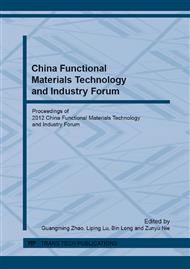p.345
p.350
p.354
p.358
p.363
p.369
p.374
p.383
p.389
Alumina Nano-Wires and Nano-Belts Fabricated by an Effective Chemical Etching of PAA Template
Abstract:
A tilted cathode was adopted to change the distribution of the electric field during the second anodization of the two-step method for fabricating nanoporous anodic alumina (NanoPAA). A variety of controllable patterns of NanoPAA templates were firstly prepared. After that, the functional nanostructures of alumina such as nanowires and nanobelts were accomplished by chemically etching the NanoPAA templates with phosphoric acid. In addition, the formation mechanisms of alumina nanopores and diverse low dimensional nanostructures influenced by the modified electric field were also discussed from the surface morphologies imaged by the field emission scanning electron microscopy technology. This chemical etching method was taken for an alternative approach for quickly fabricating low dimensional alumina nanostructures with high production and cost-effective.
Info:
Periodical:
Pages:
363-368
Citation:
Online since:
May 2013
Authors:
Price:
Сopyright:
© 2013 Trans Tech Publications Ltd. All Rights Reserved
Share:
Citation:


